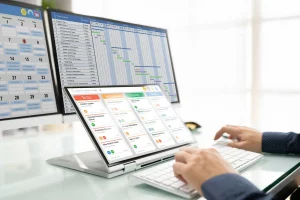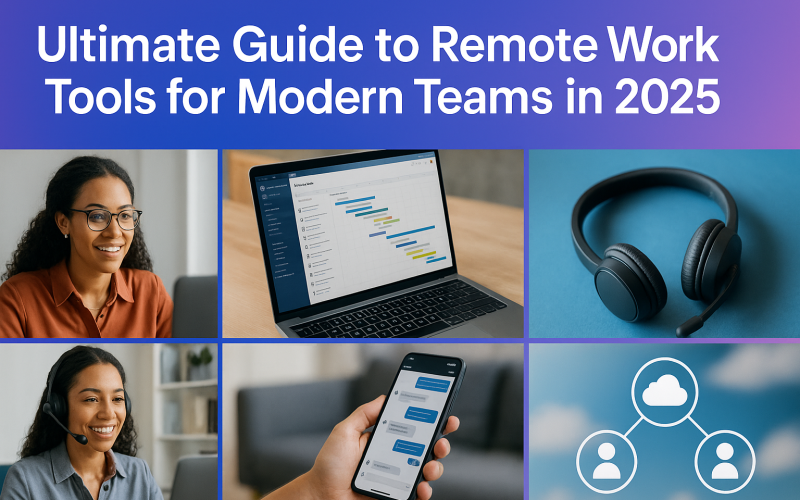Introduction
The remote work boom of earlier years has settled into a permanent feature of modern business life. From two‑person start‑ups to global enterprises, distributed teams now deliver products, serve clients, and innovate on schedules that cross half the planet. Yet distance still creates friction. Time‑zone gaps slow conversations, messy document control spreads errors, and weak security leaves data exposed. The right digital toolkit solves those problems, transforming scattered contributors into a focused unit. This ultimate guide to remote work tools for modern teams in 2025 explains which categories matter most, highlights leading platforms, and shows practical ways to blend them into a smooth daily workflow. Whether you manage developers in three countries or juggle freelance gigs from a kitchen desk, you will finish with a clear roadmap to build a productive, secure, and enjoyable remote environment.
What Is a Remote Work Tool and Why It Matters
A remote work tool is any piece of software or hardware that replaces or enhances in‑office interaction. Good tools bridge location gaps, speed decision‑making, protect intellectual property, and sustain team culture. In 2025 high‑impact platforms share three traits. They integrate with other apps to eliminate data silos; they use artificial intelligence to automate repetitive steps; and they provide flexible pricing that scales from five seats to five thousand without painful migrations.
Communication Platforms: Core of Connection

Real‑Time Messaging
Instant chat keeps teams quick. Platforms such as Slack Next and Microsoft Loop Chat roll out AI summaries that catch latecomers up in seconds. Loop Chat even generates quick‑reply drafts that match your tone, transforming late‑night questions into morning clarity. Choose a tool that lets you segment channels by client, project, and social topics—this separation trims notification noise and protects privacy.
Video Collaboration
Video fatigue peaked in 2023, pushing providers to innovate. Zoom Ultra now offers “adaptive framing,” which uses computer vision to keep speakers centered even when they move, cutting the need to fuss with webcams. Google Meet Live captions tone of voice, flagging uncertain phrases with gentle highlights so multilingual teams can follow subtle cues. When selecting a platform, test latency on low‑bandwidth networks and confirm recording storage complies with local data laws.
Project & Task Management

Kanban and Beyond
Linear, Asana, and ClickUp remain big names, but 2025 sees Notion Tasks integrating GPT‑powered suggestion blocks that draft timelines and assign owners based on past patterns. Trello 2 adds dependency lines, finally letting card lovers track Gantt‑style cascades without external plug‑ins. Look for features such as native goal dashboards and real‑time capacity charts; they replace endless status calls with visual certainty.
Documentation Hubs
Well‑organized knowledge keeps remote teams aligned. Confluence Cloud AI auto‑indexes video transcripts, converting presentations into searchable pages. Slite‑AI annotates docs with quick summaries, meaning new hires can skim hundreds of pages in minutes. Strong permission controls matter here: ensure you can limit sensitive strategy notes to senior staff while leaving onboarding guides open to all.
Cloud Storage and File Sync

Version Safety
Dropbox Quantum introduces “branch” versions, similar to code repositories. Designers can spin off a draft without risking the master file, then merge when approved. Google Drive X offers auto‑redact tools that strip personal identifiers from PDFs before sharing externally. Prioritize platforms with block‑level sync, which updates only edited segments—not whole files—saving bandwidth for globe‑spanning teams.
Security and Privacy
Zero‑Trust Access
Traditional VPNs struggle under scattered logins. Twingate and Perimeter 81 deliver identity‑based tunnels that restrict each user to exactly the resources they need. Duo Mobile adds face‑match biometrics to push notifications, halving login breaches that rely on stolen phones. Any security suite you select should support hardware keys, real‑time threat alerts, and compliance dashboards that map directly to ISO 27001 or SOC 2—certifications many clients now demand.
Data Loss Prevention
Nightly backups once felt sufficient, but ransomware can strike between those windows. Backblaze Instant Snapshots save file versions every sixty seconds and isolate them from local attacks. Meanwhile, Proofpoint Remote filters outbound email for accidental leaks, flagging attachments that include financial numbers. Choose DLP tools that run quietly in the background; intrusive pop‑ups tempt users to disable protection.
Time‑Zone Coordination
Async Video Updates
Loom Pulse compresses a five‑minute screencast into a flip‑book preview so teammates know content before hitting play. SendSpark stacks multiple short clips into playlist “flows” that mirror meeting agendas—watchers skip straight to sections that affect them. Utilize async video for status reports or design demos, freeing calendars from live sessions while preserving human tone.
Global Clock Helpers
EveryTime, a web widget, embeds a meeting‑time slider into Slack threads, showing local times for all participants. Calendly Globe auto‑suggests slots that avoid lunch hours in each locale. These simple aids prevent midnight pings that sour morale.
Virtual Co‑Working and Culture

Digital Office Spaces
Gather Town evolved into Gather Grid 2, hosting 2‑D office maps with one‑click drop‑ins. Workroom VR offers 3‑D spaces for brainstorming that accept stylus sketches while capturing hand gestures for remote sign‑language users. While not mandatory, a playful space boosts belonging—schedule weekly coffee breaks there.
Recognition and Wellness
Bonusly 2025 integrates with GitHub and Jira, allowing automatic kudos for merged pull requests or task completions. Spill Chatbot offers anonymous therapy sessions within Slack, under employer‑subsidized schemes. Select perks that fit company culture; forced fun drains energy.
Automation & AI Assistants
Workflow Builders
Zapier Neon includes conditional branches powered by natural‑language prompts—type “when invoice paid, send thank‑you email, then archive PDF,” and the system builds it. Make (formerly Integromat) adds latency graphs so you can spot slow steps. Automating hand‑offs cuts errors and gives back focus time.
Personal AI Helpers
Reclaim AI plans your week, sliding individual tasks between fixed events while respecting focus time. Otter Pilot, embedded in Zoom Ultra, transcribes, tags speakers, and drafts action items automatically. Verify that transcripts stay encrypted and delete after export if regulations mandate.
Hardware Upgrades for Remote Efficiency

Portable Second Screens
Thin‑panel OLED monitors fold like magazines, weighing under two pounds. Brands such as LuminaScreen plug a single USB‑C cable that carries power, video, and touch input—ideal for café workers craving dual displays.
Adaptive Noise‑Canceling Headsets
Sony Pro Link learns your typing cadence and tunes mics to ignore it, keeping calls clear even during frantic note‑taking. Spare‑ear sensors detect when you remove one cup and auto‑pause playback.
Integrating the Tool Stack
Buying every shiny app leads to overlap and fatigue. Map workflows first: brief, build, review, deliver, support. Assign one core tool per stage and ensure open APIs for data flow. For example, Slack for chat, Asana for tasks, Google Drive for files, Zoom for live calls, and 1Password Business for credentials. Then add specialized helpers—Otter for transcription or Bonusly for morale—as needed. Review usage quarterly; sunset low‑adoption tools to save money and mental load.
Table – Recommended Tools by Category and Team Size
| Category | Small Team (<25) | Mid Team (25–200) | Enterprise (200+) |
|---|---|---|---|
| Chat | Slack Next Free | Slack Pro | Microsoft Loop Chat |
| Video | Google Meet Live | Zoom Ultra | Webex Suite |
| Tasks | Notion Tasks | Asana Premium | Jira Cloud |
| Docs | Slite‐AI | Confluence Cloud AI | Confluence Data Center |
| Storage | Google Drive X | Dropbox Quantum | Box Enterprise |
| Security | 1Password Teams | Twingate | Perimeter 81 |
| Async Video | Loom Pulse | Loom Business | SendSpark Teams |
| Culture | Gather Grid 2 | Bonusly | Microsoft Viva |
All pricing based on March 2025 public lists; check for discounts or regional offers.
Best Practices for Roll‑Out
Soft‑launch tools to pilot groups. Collect feedback after two weeks regarding interface clarity, notification noise, and integration bugs. Provide short video tutorials and quick‑reference cheat sheets. Celebrate early wins—time saved, bugs squashed—to build momentum. Finally, establish a digital‑first handbook that documents meeting norms, response‑time expectations, file‑naming rules, and security responsibilities.
Conclusion
Remote success in 2025 rests on more than Wi‑Fi and willpower. It demands a curated toolkit that covers instant chat, reliable video, structured tasks, airtight security, and a sense of shared culture. By weighing integration ease, AI support, and cost scalability, leaders can craft a stack that turns distance into an advantage, not a hurdle. Start small, iterate, and watch productivity grow—one smart tool at a time.
Call to Action
Ready to upgrade your remote workflow? Download our free tool‑comparison checklist, share it with your team, and schedule a thirty‑minute audit meeting this week. The perfect stack is closer than you think—start building it today.










